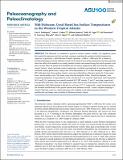| dc.contributor.author | Rodriguez, LG | |
| dc.contributor.author | Cohen, AL | |
| dc.contributor.author | Ramirez, W | |
| dc.contributor.author | Oppo, DW | |
| dc.contributor.author | Pourmand, A | |
| dc.contributor.author | Edwards, RL | |
| dc.contributor.author | Alpert, AE | |
| dc.contributor.author | Mollica, N | |
| dc.date.accessioned | 2022-03-15T14:46:07Z | |
| dc.date.available | 2022-03-15T14:46:07Z | |
| dc.date.issued | 2019-01-01 | |
| dc.identifier.uri | https://hdl.handle.net/1721.1/141184 | |
| dc.description.abstract | ©2019. The Authors. The Holocene is considered a period of relative climatic stability, but significant proxy data-model discrepancies exist that preclude consensus regarding the postglacial global temperature trajectory. In particular, a mid-Holocene Climatic Optimum, ~9,000 to ~5,000 years BP, is evident in Northern Hemisphere marine sediment records, but its absence from model simulations raises key questions about the ability of the models to accurately simulate climate and seasonal biases that may be present in the proxy records. Here we present new mid-Holocene sea surface temperature (SST) data from the western tropical Atlantic, where twentieth-century temperature variability and amplitude of warming track the twentieth-century global ocean. Using a new coral thermometer Sr-U, we first developed a temporal Sr-U SST calibration from three modern Atlantic corals and validated the calibration against Sr-U time series from a fourth modern coral. Two fossil corals from the Enriquillo Valley, Dominican Republic, were screened for diagenesis, U-series dated to 5,199 ± 26 and 6,427 ± 81 years BP, respectively, and analyzed for Sr/Ca and U/Ca, generating two annually resolved Sr-U SST records, 27 and 17 years long, respectively. Average SSTs from both corals were significantly cooler than in early instrumental (1870–1920) and late instrumental (1965–2016) periods at this site, by ~0.5 and ~0.75 °C, respectively, a result inconsistent with the extended mid-Holocene warm period inferred from sediment records. A more complete sampling of Atlantic Holocene corals can resolve this issue with confidence and address questions related to multidecadal and longer-term variability in Holocene Atlantic climate. | en_US |
| dc.language.iso | en | |
| dc.publisher | American Geophysical Union (AGU) | en_US |
| dc.relation.isversionof | 10.1029/2019PA003571 | en_US |
| dc.rights | Creative Commons Attribution-NonCommercial-NoDerivs License | en_US |
| dc.rights.uri | http://creativecommons.org/licenses/by-nc-nd/4.0/ | en_US |
| dc.source | Wiley | en_US |
| dc.title | Mid-Holocene, Coral-Based Sea Surface Temperatures in the Western Tropical Atlantic | en_US |
| dc.type | Article | en_US |
| dc.identifier.citation | Rodriguez, LG, Cohen, AL, Ramirez, W, Oppo, DW, Pourmand, A et al. 2019. "Mid-Holocene, Coral-Based Sea Surface Temperatures in the Western Tropical Atlantic." Paleoceanography and Paleoclimatology, 34 (7). | |
| dc.contributor.department | Woods Hole Oceanographic Institution | |
| dc.relation.journal | Paleoceanography and Paleoclimatology | en_US |
| dc.eprint.version | Final published version | en_US |
| dc.type.uri | http://purl.org/eprint/type/JournalArticle | en_US |
| eprint.status | http://purl.org/eprint/status/PeerReviewed | en_US |
| dc.date.updated | 2022-03-15T14:43:27Z | |
| dspace.orderedauthors | Rodriguez, LG; Cohen, AL; Ramirez, W; Oppo, DW; Pourmand, A; Edwards, RL; Alpert, AE; Mollica, N | en_US |
| dspace.date.submission | 2022-03-15T14:43:29Z | |
| mit.journal.volume | 34 | en_US |
| mit.journal.issue | 7 | en_US |
| mit.license | PUBLISHER_CC | |
| mit.metadata.status | Authority Work and Publication Information Needed | en_US |
